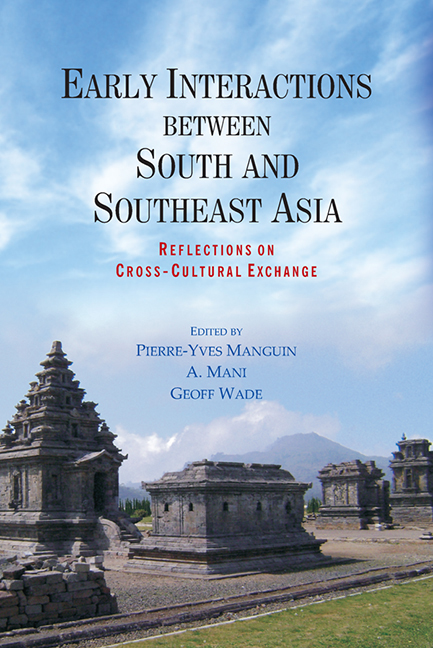Book contents
- Frontmatter
- Contents
- FOREWORD
- Preface
- Introduction
- PART I New Archaeological Evidence from South Asia and Southeast Asia
- PART II Localisation in Southeast Asia
- 11 Tamil Merchants and the Hindu-Buddhist Diaspora in Early Southeast Asia
- 12 The Spread of Sanskrit in Southeast Asia
- 13 The Early Inscriptions of Indonesia and the Problem of the Sanskrit Cosmopolis
- 14 Indian Architecture in the ‘Sanskrit Cosmopolis’: The Temples of the Dieng Plateau
- 15 The Importance of Gupta-period Sculpture in Southeast Asian Art History
- 16 Individuals under the Glaze: Local Transformations of Indianisation in the Decorative Lintels of Angkor
- 17 Early Musical Exchange between India and Southeast Asia
- 18 Buddhism and the Circulation of Ritual in Early Peninsular Southeast Asia
- 19 Early Buddhism in Myanmar: Ye Dhammā Inscriptions from Arakan
- 20 Hindu Deities in Southern Vietnam: Images on Small Archaeological Artefacts
- 21 ‘The Depositing of the Embryo’ – Temple Consecration Rituals in the Hindu Tradition of South and Southeast Asia: A Study of the Textual and Archaeological Evidence
- 22 Localisation of Indian Infl uences as Refl ected in the Laotian Versions of the Ramayana
- 23 Broken Threads: Contested Histories of Brahminism in Cambodia and Thailand and the Construction of Ritual Authority
- LIST OF CONTRIBUTORS
- INDEX
15 - The Importance of Gupta-period Sculpture in Southeast Asian Art History
from PART II - Localisation in Southeast Asia
Published online by Cambridge University Press: 21 October 2015
- Frontmatter
- Contents
- FOREWORD
- Preface
- Introduction
- PART I New Archaeological Evidence from South Asia and Southeast Asia
- PART II Localisation in Southeast Asia
- 11 Tamil Merchants and the Hindu-Buddhist Diaspora in Early Southeast Asia
- 12 The Spread of Sanskrit in Southeast Asia
- 13 The Early Inscriptions of Indonesia and the Problem of the Sanskrit Cosmopolis
- 14 Indian Architecture in the ‘Sanskrit Cosmopolis’: The Temples of the Dieng Plateau
- 15 The Importance of Gupta-period Sculpture in Southeast Asian Art History
- 16 Individuals under the Glaze: Local Transformations of Indianisation in the Decorative Lintels of Angkor
- 17 Early Musical Exchange between India and Southeast Asia
- 18 Buddhism and the Circulation of Ritual in Early Peninsular Southeast Asia
- 19 Early Buddhism in Myanmar: Ye Dhammā Inscriptions from Arakan
- 20 Hindu Deities in Southern Vietnam: Images on Small Archaeological Artefacts
- 21 ‘The Depositing of the Embryo’ – Temple Consecration Rituals in the Hindu Tradition of South and Southeast Asia: A Study of the Textual and Archaeological Evidence
- 22 Localisation of Indian Infl uences as Refl ected in the Laotian Versions of the Ramayana
- 23 Broken Threads: Contested Histories of Brahminism in Cambodia and Thailand and the Construction of Ritual Authority
- LIST OF CONTRIBUTORS
- INDEX
Summary
The importance of Gupta-period sculpture to the art of South Asia, Southeast Asia, and East Asia has been stressed by many scholars for over a century. The Gupta Period is roughly the fourth-sixth centuries during which the Gupta dynasty controlled much of north India. The Gupta-period artistic style was fairly consistent and emphasised an idealised naturalism that has been praised for its artistic excellence. It is also seen to have relationships with some of the earliest art that developed in Southeast Asia. My paper outlines how these relationships can be defined. It places the Gupta-related art into the context of other Indian art, of Sri Lankan art, of Chinese art, and then each of these with Southeast Asian art. It aims to question several of the standard scholarly assumptions made in regard to the relationship of Gupta-period and Southeast Asian art.
WHAT IS GUPTA-PERIOD ART?
The Gupta dynasty began rule in 320, reached its political zenith around 400, and was losing its strength a century later, by around 500. There is very little art that can be attributed to the fourth century, during the initial decades of Gupta political growth. Indeed there is little art in north India that can be placed in this century, following the end of the Kushan dynastic control and the rise of the Guptas. The Guptas themselves appear not to have been patrons of sculpture or temples, as we have no sculpture and only a few temple remains that were patronized by them. Their interest in visual arts seems limited to coins, with their gold coins reaching a high level of artistic excellence. Members of the Vakataka dynasty, linked through marriage with the Guptas, were, on the other hand, major patrons of both Hindu and Buddhist sculpture and temples. The Buddhist cave temples at Ajanta were done under the Vakatakas in the second half of the fifth century. By the middle of the sixth century we can say the Gupta-period style of art is ending, and during the seventh-century, sculpture in north India will become transformed into a much more formalised, flattened, and conceptual style.
- Type
- Chapter
- Information
- Early Interactions between South and Southeast AsiaReflections on Cross-Cultural Exchange, pp. 317 - 332Publisher: ISEAS–Yusof Ishak InstitutePrint publication year: 2011



